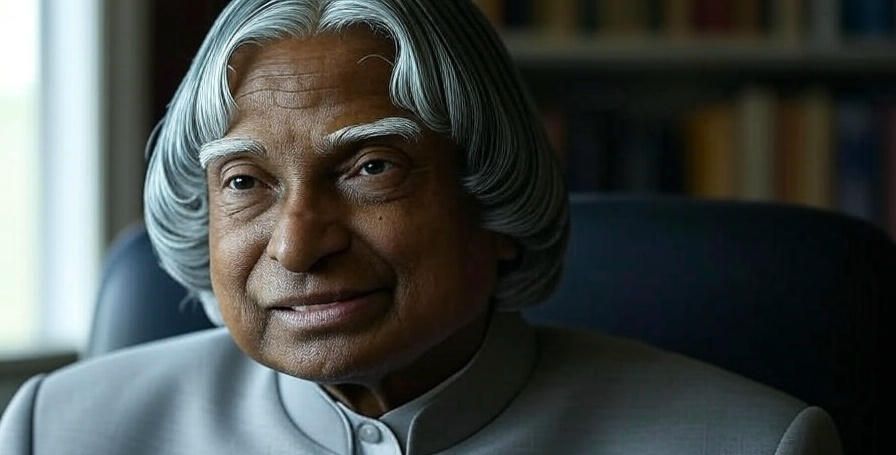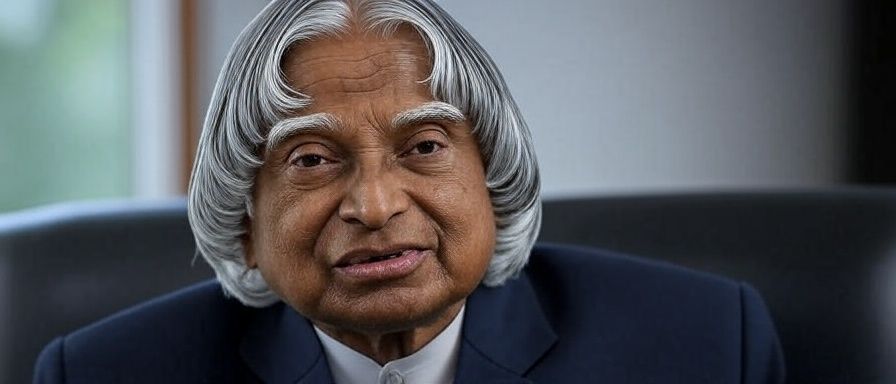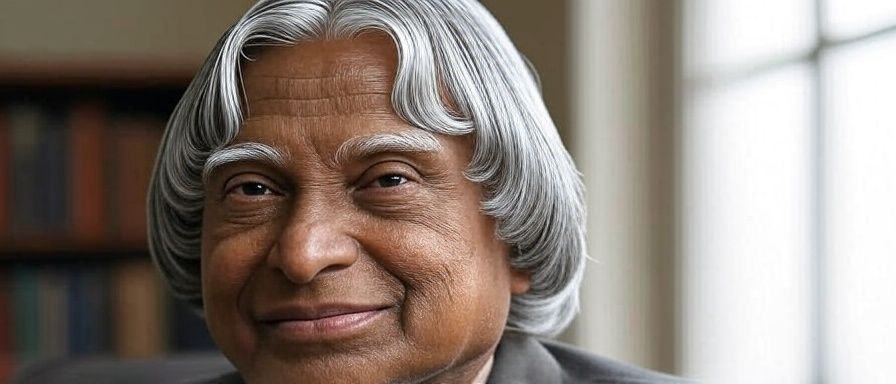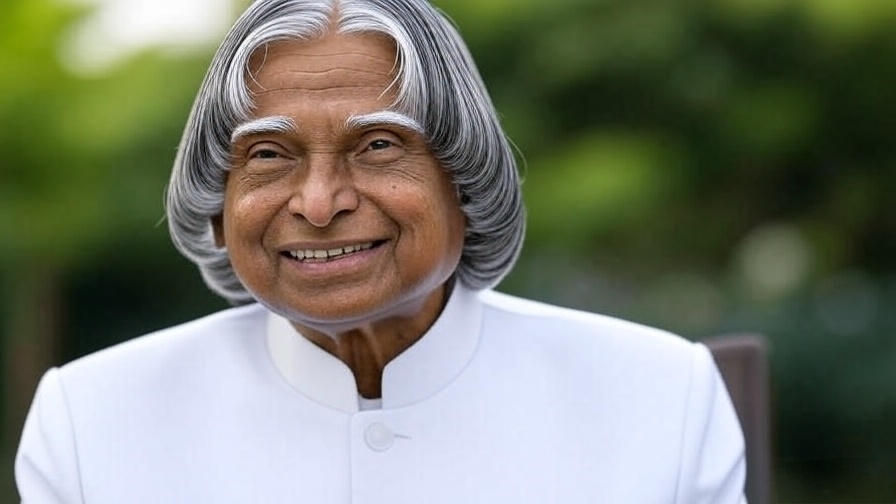Dr. Avul Pakir Jainulabdeen Abdul Kalam, fondly known as Dr. APJ Abdul Kalam, was a visionary scientist, an inspiring leader, and a beloved figure in India and beyond. Often referred to as the “Missile Man of India” for his contributions to India’s space and defense programs, and later as the “People’s President” for his humility and connection with the masses, Dr. Kalam’s life is a remarkable story of dedication, innovation, and service to humanity. This article explores his life, achievements, values, and lasting legacy in a simple and detailed manner, making it accessible to all audiences.

𝗘𝗮𝗿𝗹𝘆 𝗟𝗶𝗳𝗲 𝗮𝗻𝗱 𝗛𝘂𝗺𝗯𝗹𝗲 𝗕𝗲𝗴𝗶𝗻𝗻𝗶𝗻𝗴𝘀
Dr. APJ Abdul Kalam was born on October 15, 1931, in the small coastal town of Rameswaram in Tamil Nadu, India. He was born into a modest Muslim family, with his father, Jainulabdeen, working as a boat owner and imam at a local mosque, and his mother, Ashiamma, managing the household. The family faced financial challenges, and young Kalam contributed by selling newspapers to support them. Despite the hardships, his parents instilled in him values of honesty, discipline, and compassion.
Kalam’s curiosity and love for learning were evident from a young age. He was deeply inspired by the natural beauty of Rameswaram and the stories of his teachers, who encouraged his inquisitive mind. He attended Schwartz Higher Secondary School in Ramanathapuram and later pursued a degree in physics from St. Joseph’s College, Tiruchirappalli. However, his true passion lay in aeronautics, which led him to study aerospace engineering at the Madras Institute of Technology (MIT) in Chennai.
His early life was marked by determination to overcome obstacles. Kalam often spoke about how his family’s struggles and his small-town upbringing shaped his resilience and belief in hard work. He once said, “Dreams are not those which come while we are sleeping, but dreams are those when you don’t sleep before fulfilling them.” This mindset became the cornerstone of his extraordinary journey.
𝗝𝗼𝘂𝗿𝗻𝗲𝘆 𝗮𝘀 𝗮 𝗦𝗰𝗶𝗲𝗻𝘁𝗶𝘀𝘁
After graduating from MIT in 1960, Dr. Kalam joined India’s Defense Research and Development Organisation (DRDO) as a scientist. His early work focused on designing a small hovercraft, but his true calling came when he joined the Indian Space Research Organisation (ISRO). At ISRO, he played a pivotal role in India’s civilian space program, particularly in the development of satellite launch vehicles.
One of his most significant contributions was his leadership in the development of the Satellite Launch Vehicle (SLV-III), India’s first indigenous satellite launch vehicle. In 1980, the SLV-III successfully placed the Rohini satellite into orbit, making India one of the few nations with satellite launch capabilities. This achievement marked a turning point for India’s space program and established Kalam as a key figure in the scientific community.
In 1982, Dr. Kalam returned to DRDO to lead India’s Integrated Guided Missile Development Programme (IGMDP). Under his leadership, India developed several indigenous missiles, including Agni, a long-range ballistic missile, and Prithvi, a surface-to-surface missile. His work on these projects earned him the nickname “Missile Man of India.” Kalam’s ability to simplify complex scientific concepts and inspire his team was instrumental in overcoming technical and financial challenges during these projects.
His contributions weren’t limited to missiles and space technology. Kalam was a visionary who believed in using science for societal good. He collaborated with medical professionals to develop low-cost coronary stents and lightweight calipers for polio patients, showcasing his commitment to affordable innovation.

𝗥𝗼𝗹𝗲 𝗮𝘀 𝗮 𝗟𝗲𝗮𝗱𝗲𝗿 𝗮𝗻𝗱 𝗠𝗲𝗻𝘁𝗼𝗿
Dr. Kalam’s leadership style was unique. He believed in empowering others, fostering teamwork, and leading by example. His humility and accessibility made him a mentor to countless scientists, engineers, and students. He often shared stories from his own life to inspire young minds, emphasizing that success comes from perseverance and a willingness to learn from failures.
During his tenure as the Scientific Adviser to the Defense Minister (1992–1999), Kalam played a key role in India’s 1998 Pokhran-II nuclear tests, which established India as a nuclear power. Despite the controversies surrounding the tests, Kalam maintained that India’s nuclear capabilities were for defense and deterrence, not aggression.
Kalam’s ability to connect with people extended beyond the scientific community. He was known for his motivational speeches, where he encouraged youth to dream big and work hard. His books, such as Wings of Fire, Ignited Minds, and India 2020, became bestsellers, offering insights into his life, vision for India, and belief in the power of youth to transform the nation.
𝗣𝗿𝗲𝘀𝗶𝗱𝗲𝗻𝗰𝘆: 𝗧𝗵𝗲 𝗣𝗲𝗼𝗽𝗹𝗲’𝘀 𝗣𝗿𝗲𝘀𝗶𝗱𝗲𝗻𝘁 (𝟮𝟬𝟬𝟮–𝟮𝟬𝟬𝟳)
In 2002, Dr. APJ Abdul Kalam was elected as the 11th President of India, serving from July 25, 2002, to July 25, 2007. His presidency was a historic moment, as he became the first scientist and bachelor to occupy the Rashtrapati Bhavan, India’s presidential palace. Kalam’s tenure was marked by his simplicity, accessibility, and focus on education, innovation, and youth empowerment.
Unlike traditional presidents, Kalam broke protocol to connect with ordinary citizens, especially students. He traveled across India, visiting schools, colleges, and rural communities, inspiring millions with his vision of a developed India by 2020. He introduced initiatives like Providing Urban Amenities in Rural Areas (PURA), aimed at bridging the urban-rural divide through infrastructure and economic development.
Kalam’s presidency was defined by his “people-first” approach. He opened the Rashtrapati Bhavan to the public, interacted with children, and responded to letters and emails from citizens. His speeches, filled with optimism and practical advice, resonated with people from all walks of life. He often said, “The purpose of education is to make good human beings with skill and expertise.
”Even as president, Kalam remained a teacher at heart. He continued to engage with students, encouraging them to ask questions and pursue their dreams. His ability to connect with the youth earned him the title of “People’s President.”

𝗩𝗶𝘀𝗶𝗼𝗻 𝗳𝗼𝗿 𝗜𝗻𝗱𝗶𝗮 𝟮𝟬𝟮𝟬
One of Dr. Kalam’s most ambitious contributions was his vision for a developed India by 2020, outlined in his book India 2020: A Vision for the New Millennium, co-authored with Y.S. Rajan. He envisioned India as a global leader in technology, education, and economic development, with a focus on five key areas: agriculture, education, healthcare, infrastructure, and information technology.
Kalam believed that India’s greatest asset was its youth, and he urged young people to take responsibility for the nation’s progress. His vision emphasized self-reliance, innovation, and sustainable development. He advocated for renewable energy, rural empowerment, and the use of technology to solve everyday problems.
Although India has not fully achieved the goals outlined in India 2020, Kalam’s vision continues to inspire policymakers, educators, and citizens. His ideas laid the foundation for initiatives like Digital India, Make in India, and the push for renewable energy.
𝗣𝗲𝗿𝘀𝗼𝗻𝗮𝗹 𝗟𝗶𝗳𝗲 𝗮𝗻𝗱 𝗩𝗮𝗹𝘂𝗲𝘀
Dr. Kalam’s personal life was a reflection of his simplicity and discipline. He was a vegetarian, practiced meditation, and was deeply spiritual. He drew inspiration from multiple religions and cultures, often quoting from the Quran, Bible, and Bhagavad Gita. His love for music, particularly playing the veena, and his passion for writing poetry added a creative dimension to his personality.
Kalam never married, dedicating his life to science, education, and public service. He lived frugally, donating much of his earnings to charitable causes and educational initiatives. His humility was legendary—whether interacting with world leaders or schoolchildren, he treated everyone with equal respect.
One of his core beliefs was the importance of dreaming big. He often said, “You have to dream before your dreams can come true.” He encouraged people to set ambitious goals and work tirelessly to achieve them, emphasizing that failure is a stepping stone to success.
𝗟𝗲𝗴𝗮𝗰𝘆 𝗮𝗻𝗱 𝗜𝗺𝗽𝗮𝗰𝘁
Dr. APJ Abdul Kalam passed away on July 27, 2015, while delivering a lecture at the Indian Institute of Management (IIM) Shillong. His sudden death at the age of 83 was a shock to the nation, but his legacy continues to inspire millions. He collapsed during his speech, a poignant reminder of his lifelong dedication to teaching and inspiring others.
Kalam’s contributions to India’s space and defense programs laid the foundation for the country’s technological advancements. His work on SLV-III, Agni, and Prithvi missiles strengthened India’s strategic capabilities, while his efforts in affordable healthcare and education made technology accessible to the masses.
Beyond his scientific achievements, Kalam’s greatest legacy is his ability to inspire. His books, speeches, and personal interactions motivated generations of Indians to believe in themselves and their country. He championed the idea that every individual, regardless of their background, could contribute to nation-building.
In recognition of his contributions, Dr. Kalam received numerous awards, including:
✓ Padma Bhushan (1981): India’s third-highest civilian honor.
✓ Padma Vibhushan (1990): India’s second-highest civilian honor.
✓ Bharat Ratna (1997): India’s highest civilian honor.
✓ Hoover Medal (2009): An American award for humanitarian contributions.
Honorary doctorates from over 40 universities worldwide.After his passing, the Indian government declared October 15, his birth anniversary, as World Students’ Day, celebrating his love for education and youth empowerment. The United Nations also recognized his contributions by naming his birthday as a day to honor students globally.
𝗟𝗲𝘀𝘀𝗼𝗻𝘀 𝗳𝗿𝗼𝗺 𝗗𝗿. 𝗞𝗮𝗹𝗮𝗺’𝘀 𝗟𝗶𝗳𝗲
Dr. Kalam’s life offers valuable lessons for people of all ages and backgrounds:
✓ Dream Big, Work Hard: Kalam’s journey from a small town to the presidency shows that dreams, when backed by hard work, can become reality.
✓ Stay Humble: Despite his achievements, Kalam remained grounded and approachable, treating everyone with respect.
✓ Embrace Failure: He viewed failures as opportunities to learn and grow, a mindset that helped him overcome challenges.
✓ Serve Others: Kalam’s life was dedicated to serving his country and its people, emphasizing the importance of giving back.
✓ Never Stop Learning: His curiosity and love for knowledge kept him innovating and inspiring throughout his life.
𝗗𝗿. 𝗞𝗮𝗹𝗮𝗺’𝘀 𝗜𝗻𝗳𝗹𝘂𝗲𝗻𝗰𝗲 𝗧𝗼𝗱𝗮𝘆
Dr. Kalam’s ideas continue to shape India’s policies and aspirations. His emphasis on education and innovation is reflected in initiatives like the National Education Policy (NEP) 2020, which aims to transform India’s education system. His vision for rural development inspired programs like Smart Villages and Digital India, which seek to bridge the urban-rural gap.
Globally, Kalam’s story resonates as an example of how determination and vision can overcome adversity. His books are widely read, and his speeches are shared on platforms like YouTube, inspiring people worldwide. Educational institutions, scholarships, and awards named after him continue to promote his values of excellence and service.
𝗖𝗼𝗻𝗰𝗹𝘂𝘀𝗶𝗼𝗻
Dr. APJ Abdul Kalam was more than a scientist or president—he was a teacher, dreamer, and beacon of hope. His journey from the shores of Rameswaram to the global stage is a testament to the power of perseverance, humility, and vision. Whether it was launching satellites, developing missiles, or inspiring students, Kalam’s life was dedicated to making the world a better place.
For young people, he remains a role model who showed that no dream is too big, no obstacle too great. For leaders, he exemplified how to lead with compassion and integrity. And for humanity, he left behind a legacy of using knowledge and innovation for the greater good.
As we reflect on Dr. Kalam’s life, let us remember his words: “The best brains of the nation may be found on the last benches of the classroom.” His belief in the potential of every individual reminds us that greatness lies within us all, waiting to be ignited by dreams, hard work, and a commitment to making a difference.

